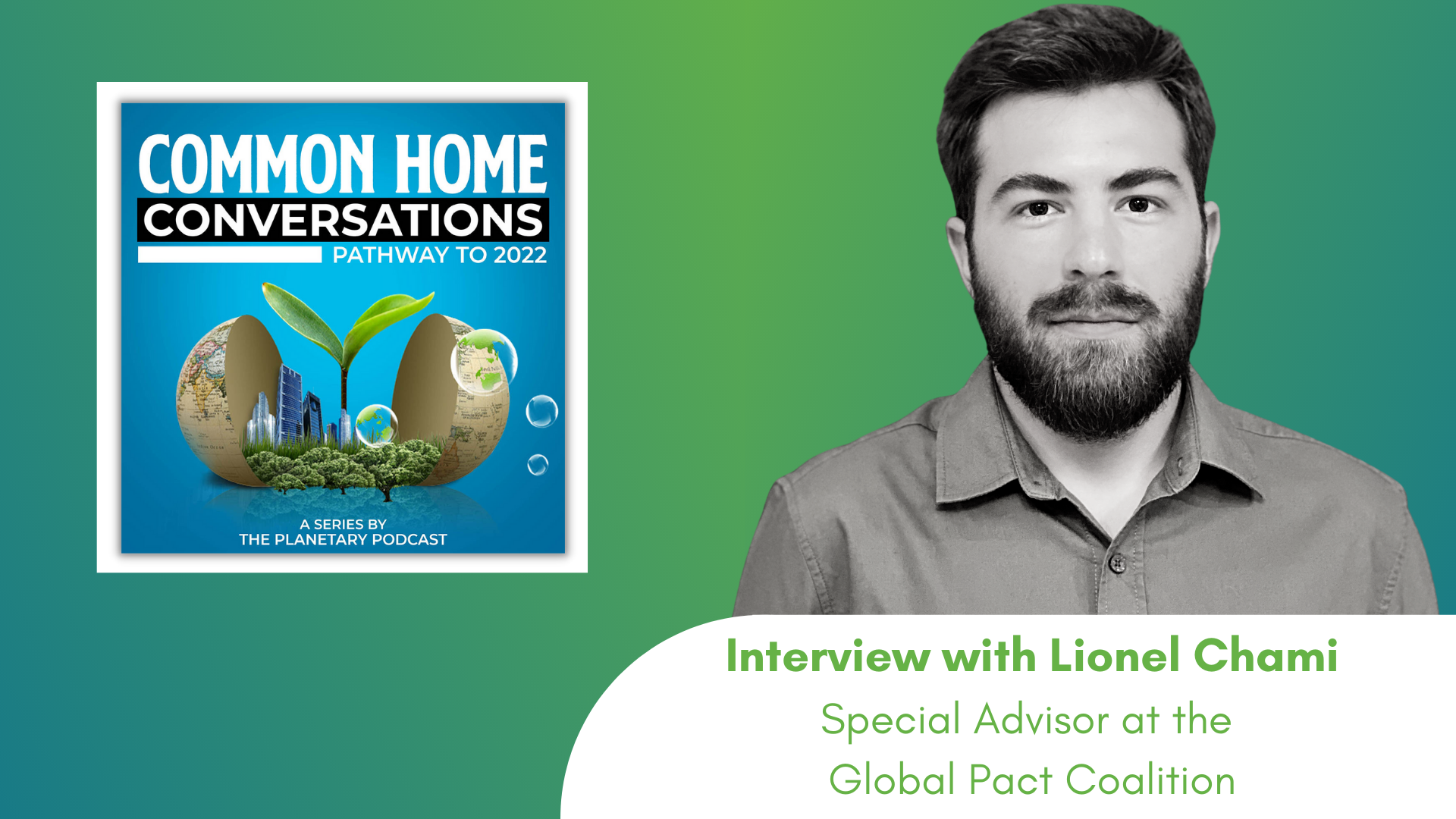Interview with Lionel Chami, Special Advisor at the Global Pact Coalition
Interview Transcript
Transcribed by Otter AI
Kimberly White
Hello and welcome to Common Home Conversations. Today we’re joined by Lionel Chami, Special Advisor at the Global Pact Coalition. Thank you so much for joining us, Lionel!
Lionel Chami
Thank you.
Kimberly White
Can you tell us about your work with the Global Pact for the Environment?
Lionel Chami
The Global Pact for the Environment exists because there’s a deficiency in international environmental law, which is the legal framework that governs the environment at a global level. And the problem we have is that there’s a deficiency of the level of implementation. So we’re not implementing the current norms enough, we’re not doing it sufficiently, we’re not doing it efficiently enough. And we also have a deficiency at the level of lawmaking, so we don’t have the right laws to tackle the extent of the problem. That’s where the Global Pact for the Environment comes in. The Global Pact for the Environment is a consensus text among the biggest environmental lawyers of the world to lay down what is needed in one text to reform environmental law and governance on a global level. So, to get back to my work, what I do concretely is to try to convince states, state representatives, NGOs, scholars, etc., that this is a good idea, that we have a fundamental problem at the level of lawmaking and the level of implementation, and that this pact could help resolve these problems.
Kimberly White
That’s fantastic. Now, in response to the latest IPCC report, the UN Secretary-General called the report a code red for humanity, stressing the need for immediate action on climate. Globally, temperatures have already risen 1.2 degrees and continue to climb. And despite the intensifying adverse impacts of climate change, policies have not yet risen to this immense challenge. How would a Global Pact for the Environment help us better address the environmental crises facing our global community?
Lionel Chami
That’s a very good question because it tackles what is at the heart of the problem, which is global warming, climate change. Now, what’s different with a Global Pact for the Environment is that it tackles these issues, not from the perspectives of targets and financial goals like you have in the Paris Agreement, which is the global treaty on climate change. The Global Pact for the Environment, as the name suggests, is global in scope, which means that it addresses the environment as a whole. It doesn’t just look at the seas, climate, biodiversity, wetlands, deserts, etc. It takes the environment as a whole. And it will help to fight climate change by delivering environmental justice. So the core of the project is a question of justice. Because climate change is a very unjust phenomenon. Rich countries, rich people will be harmed less from climate change than poor countries or poor people, depending on the geography of who you are in society, etc. So the Global Pact for the Environment seeks to recognize the environmental rights and duties of everyone, to enshrine on a global level the right of everyone to live in a healthy environment, and to recognize the duties of states and corporations to take care of the environment. So that’s the big difference with what we have right now. It’s a question of justice and it’s a question of addressing the environment, not through segmented silos, but really as a whole.
Kimberly White
Absolutely, I think that’s a challenge when we work on environmental issues; we get so focused on one issue that we tend to work in silos. So it’s excellent that the pact is global in scope and addresses the environment as a whole. Now, what are some of the biggest challenges of establishing this pact?
Lionel Chami
Now, obviously, when you’re working in international law, you have to dabble in diplomacy. Diplomacy means convincing states that what you want to do is right, and it’s right not just for you, but it’s right for them. So when we introduced the pact in 2017/2018 at the UN General Assembly, you have to convince 193 states, different states, different diplomacy, different agendas, different everything, that this pact is good for them, not just good for the planet, but that it’s in their interest. And you see that this is one of the biggest issues of environmental governance is how we reach deals on an international level. We have to find a consensus between so many players with diverging interests. And sometimes, it’s like an ego battle between the states and they sort of get lost in that battle and forget about the big issues, forget about the long term, forget about the damage that climate change is causing to the environment. And they forget about the emergency. So to convince, I think all these stakeholders, all these different states, corporations, civil society, people with different outlooks, people who don’t really understand how the law works, who have different interests perspectives, I think that’s the biggest challenge, to put everyone at the same table and get them to agree on a single text.
Kimberly White
Yes, that’s always a challenge. Now, which states have been the biggest supporters of the pact thus far?
Lionel Chami
The biggest supporters of the pact can be found, I think, first of all, among the community of environmental lawyers. So an environmental lawyer is a lawyer that deals with environmental law, and it’s these people who are at the forefront of the crisis. They’re the people defending people whose houses are being destroyed or affected by pollution. They’re people who’ve been really at the forefront of tackling the environmental crisis, of tackling pollution, of tackling climate change, through a justice perspective, using the law. They’re the people that are realizing that among all the things that we could be doing, the law is not doing enough, the law is not ambitious enough, it doesn’t have the norms that we need to achieve the targets that we put, so we need to raise a threshold. And I think the lawyers were the first to notice. And when the lawyers noticed that, you start feeling an interest among NGOs, who usually used to deal with the issue through public opinion campaigns, through other means than the law. Then like, with the climate cases going on in Europe and the US, everything that’s linked to climate litigation all around the world, you start seeing more appreciation from NGOs towards using the law as a way to tackle the environmental crisis. So first, lawyers, second, NGOs, and third of all states, because some states are feeling that they’re doing enough on a national scale and they feel that other countries should be doing more. So there’s a lot of countries, like countries in Latin America, Europe, and Sub-Saharan Africa, who feel that we need this pact because we need to create a level playing field all around the world, to create a common standard to protect the environment, and so that there are no free-riders on environmental protection, and this is why you get states that have also supported this project. I think there is a growing interest among scientists because they’re seeing that, they’re not experts in the law, but they’re seeing that what we currently have, in terms of policy, in terms of legislation, is not enough. So the project is also getting traction among scientists who feel that the tool of law should be doing more. Scientists are people who’ve scrutinized the environment for a long, long time, and they’re frustrated because they’re issuing these reports, they’re writing down all these drafts, communiqués, media reports, etc., and the media reports on them sometimes, but they’re not feeling this traction among governments to do something concrete, something long-lasting, something which can enact transformative change at the level of law. So, to sum it up, we’ve had support from lawyers first, NGOs, states, and scientists, as well as all the corners of civil society.
Kimberly White
That’s wonderful. Now, just to follow up on that, what can civil society do to support the pact?
Lionel Chami
I think that can be summed up in three words: make it famous. Because so long as the pact can be ignored as the legal response to climate change, is not seen as indispensable by governments, it can be discarded, it can be forgotten about. But by making this proposal famous, not just the pact in itself, but the idea that law can do more to protect the environment. I think this is fundamental. And I think by disseminating the idea that the law can do more, that we can use the tool of the law to reclaim our right to a healthy environment; I think that’s the most important thing we can do.
Kimberly White
Now, you mentioned the right to a healthy environment. Can you elaborate on that and what that means?
Lionel Chami
So the right to a healthy environment is a fundamental right like you have a human right to freedom of speech, to property, to all of these things. You also have rights that concern the environment. Because the environment is the precondition to the exercise of human rights. If you live in an environment that is not conducive to your good health or your well-being. If you live next to a garbage dump or to an electricity plant that causes a lot of pollution, then your health is in danger and then the capacity for you to exercise these rights, these fundamental human rights of yours, and to live a dignified life in society is threatened by this unhealthy environment. And this is why a lot of jurists have come up with the idea that people have a right to a healthy environment without which they are unable to enjoy the rest of their human rights. And the right to a healthy environment is the first article of the Global Pact for the Environment. It’s been there since 2017, and it’s really the spearhead of the Global Pact.
Kimberly White
Absolutely, I think the right to a healthy environment is essential. Here in the United States, there are a lot of issues surrounding environmental justice. And specifically, one example comes to mind within the state of Louisiana. An area stretches 85 miles from New Orleans to Baton Rouge that’s been dubbed cancer alley, and it’s one of the most polluted places in the United States. The area’s just littered with oil refineries and petrochemical plants. Around 150, I believe, was the last estimate, and those plants have caused a spike in cancer rates 50 times the national average in the area.
Lionel Chami
Wow, that’s impressive, in a bad way. These are the sort of problems that exist all around the world. In Lebanon, where I come from, there’s a very big carbon plant that runs on fuel, a power plant. And they’ve also noticed that- they’ve done studies, etc.- the air pollution caused by this plant is also causing cancer rates that are 10 to 20 times higher than the national average. So we have these environmental injustices. It’s unjust because people don’t choose to live here; they just happen to live here. They can’t move, and they’re just bound to suffer from this sort of stuff. And very often, they don’t have the right environmental information. Because you feel that you have symptoms of something that’s happening because you’re living in an unhealthy environment, but you don’t know for sure. You didn’t have the right to participate when they built that project. You didn’t have the right to access environmental justice when such projects were done, or you didn’t have the right to contest them. So this is why the environment is not just a question of targets and financial objectives. It’s also a question of justice because the end goal is to have people live in a dignified environment.
Kimberly White
Absolutely. Now, in your recent article, you discuss a principled approach to international environmental governance. Within the article, you note that the environmental crises we are facing could be turned into an opportunity to “rebuild world order around the keystone of environmental protection.” Can you elaborate on the benefits of this approach?
Lionel Chami
Certainly, when you look at geopolitics today, the current world order, you see that there’s net inadequation between what we have and the current status day. So we have institutions that were built in 1945, the 1940s, as a follow-up to World War Two, but the world has changed. World War Two is over; the Cold War is over. We’re living in a multipolar world where a lot of states that used to be ignored, that weren’t great powers yet. You have India, China, Brazil, South Africa, and Nigeria. And this rise, which was justified, is causing disorder to the geopolitical world order. So what we’re saying in that article is that we can disagree on many things. We can disagree on trade; we can disagree on the economy; we can disagree on a whole lot of things. But the one thing we have to get along on is the environment. Because it’s common to everyone because it’s a butterfly effect, an ecological phenomenon, like the Amazon being a carbon sink affects the rest of humanity, wildfires in Australia affect the rest of humanity. So we need to have some sort of coordination, some sort of common foundation that allows us to build together, to have an international governance system that deals with the environment in an efficient manner. And it’s a way to get along because if countries talk to each other, through the environment, it can open the gate for countries to talk to each other on other subjects. But it’s very important to keep that line of communication open. There were many examples from the Cold War, say, when the US and the USSR were disagreeing on many subjects. However, they were openly discussing environmental issues as if they weren’t in conflict on other issues, and that probably helped resolve a certain number of conflicts in a peaceful manner. So this is what we mean by rebuilding world order around the keystone of environmental protection.
Kimberly White
So, there are more than 250 multilateral environmental agreements. How would an agreement on fundamental principles strengthen the implementation of already existing conventions?
Lionel Chami
That’s a tough one because if you look at the system of how the environmental framework works on the global level, it turns out that we have more than, like you said, 250, but other estimates say 500. So you have a big mess of multilateral environmental agreements that are concluded every year between a lot of states, and there’s no coordination among all these. It’s like if you have a puzzle, but the parts of it aren’t linked to each other; there is no coordination between one agreement and the other. So what we’re saying is let’s pick up from all these agreements, the common principles, the common principles that sort of bind this whole order and let’s recognize them in a fundamental agreement and, in that way, we create a lot of links between these conventions because we’ll make these conventions linked to each other. Let me give you an example. In the Paris Agreement, you have an implicit principle of progression. So every five or six years, states have to come up with national climate plans; they’re called Nationally Determined Contributions in the UN lingo. These plans have to be renewed every five years, and the new plan has to be more ambitious than the previous one. So from this, you can deduct that there’s a principle of progression that states have to do more and more, and they cannot go backward; they cannot backslide on environmental commitments. So one idea would be to take this principle of progression and apply it to all the spheres of environmental protection. To say that, from now, at the national level, concerning all domains, and at the international level as well, states will be forbidden to backslide on environmental commitments. It would be to say that, from this point onwards, there’s no going back. We have to go forward. That’s one example. But you can have a lot of principles on which you can give a lot of examples as well. So the Global Pact would be akin to a constitution. When you have a constitution in a state, you have a lot of values that then get disseminated, and all the laws and all the laws have to comply with the values of the Constitution. We need this at the international level to solve all these differences between the different multilateral environmental agreements.
Kimberly White
Now, with the growing public awareness of the severity of the climate emergency, do you think that Member States are ready to adopt a political declaration, reviving the idea of an ambitious Global Pact for the Environment at Stockholm+50?
Lionel Chami
Well, we certainly hope so! But we have to translate the potential of civil society; we have to translate this growing public awareness into a real movement, into something that can effect change in a specific way. You have to focus this movement into the channel of environmental justice. If civil society unites, the big NGOs, citizen movement, to demand more from states with regards to environmental law, especially with Stockholm+50, I think it’s a great opportunity to unite and to demand something concrete from states. I think if this happens, we could definitely get a very positive outcome out of Stockholm+50.
Kimberly White
Discussions centered around a civil society draft declaration kicked off in October at Stockholm+49. What do you think needs to be included for it to be a true game-changer?
Lionel Chami
For it to be a true game-changer, I think it would have to be really ambitious. It can be ambitious in two different ways. It can be a principles declaration, so a declaration that recognizes fundamental principles. This is not really new. The 1972 Stockholm Declaration enshrined a lot of principles; it laid down the rules without recognizing them of the principle of the right to a healthy environment and the duty of care of the environment. The Rio Declaration, which was adopted in 1992, laid down also some other principles, like the principles of access to information, access to environmental justice, and public participation in environmental affairs.
So Stockholm+50 and the declaration that will be adopted at UNEP at 50 need to follow this movement, and they need to recognize the new principles of environmental law. That means it can recognize the right to a healthy environment; it can recognize the principle of non-regression, which prevents backsliding on environmental regulations; it can adopt the principle of progression that from now on, we only go forward in terms of environmental protection; and it can enshrine the principle of intergenerational equity to create and to take into account the interests of future generations. So there are all these ways in which the 2022 Declaration can be a successful principles declaration. What is lacking is willpower from states.
Another solution would be for the 2022 Declaration to be a roadmap declaration, to lay down a process with targets, milestones, and everything for the adoption of a global treaty on the environment. That’s a process that is inspired by other stuff that has happened at the UN. This is how the Sustainable Development Goals were adopted. A bunch of NGOs pressed the states to start a process to lay down targets, etc., and a few years later, you had the SDGs being adopted. They’re far from ideal, but it’s still something. We think that if states do not want or are not ready to recognize new principles in the 2022 Declaration, they can lay down a roadmap. They can say, “Okay, we’re going to start this process, we’re going to lay down some targets, milestones, and in a few years, we’ll have an agreement on the principles.” This is, for example, what happened with the recent Escazu agreement. It took eight years. But at the end of eight years, the states of Latin America and the Caribbean region adopted a regional deal on environmental justice. And we think that if we could replicate this at a global level, this would really constitute progress and potentially be a game-changer for the environment.
Kimberly White
All right, and there you have it. The environment is common to us all. We should have a common foundation that allows us to build together an international governance system that addresses the environment as a whole. We should agree to a set of common principles and recognize them in a fundamental agreement. We can use the tool of the law to reclaim our right to a healthy environment. The Global Pact for the Environment seeks to recognize the environmental rights and duties of everyone, to enshrine on a global level the right of everyone to live in a healthy environment. It can help fight climate change by delivering environmental justice and recognizing the duties of states and corporations to take care of our environment. That is all for today, and thank you for joining us for this episode of Common Home Conversations Pathway to 2022. Please subscribe, share, and be sure to tune in next time to continue the conversation. And visit us at www.ThePlanetaryPress.com for more episodes and the latest news in sustainability, climate change, and the environment.
For more episodes, visit Common Home Conversations Pathway to 2022







